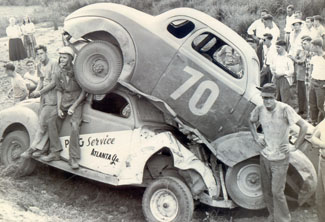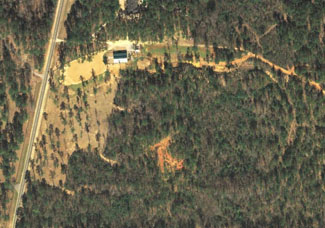Abandoned, But Not Forgotten

Billy Carden and Charlie Rush sit on the back of Carden's car while mechanic Harvey Jones looks at the camera. This accident occured at Columbus in 1949 when Rush (70) missed a turn because of the dusty conditions. Carden followed him, leading to the crash. "The track was so dusty you couldn't see your radiator cap," Rush told us.
“As to why the track closed only five years later, the only explanation I would think is bad business,” noted Bell. “A place such as Columbus Speedway takes time, commitment and money. There were many people involved in the track’s operation. They could make a good living without it.”
Charles Jenkins also noted the track’s dusty conditions.
“Of course most dirt tracks are, but this one was extra dusty,” Jenkins said. “They never had their own water truck. I saw an old city Mack truck out there once, the kind they use to wash off dirt, manure and such from the city streets.”
“Anyway, they were riding around there to nozzle off the track and spun around in their own mud,” he laughed. “You can add all the calcium chloride you want to control dust, but unless you cultivate it into the surface, it’s going to work its way to the apron quickly.
“And women aren’t going to a track and get covered in dirt,” Jenkins added. “Of course the only answer to all of that was asphalt, which was expensive.”

The Columbus Speedway sits abandoned today. The third and fourth turns, where Red Byron's accident occured, are on the right side of the picture.
The track had the stigma of not only a problem with dust, but tragedy.
“I know they had a huge turnout for a NASCAR Grand National event in 1951, but I truly think the ambience of that little boy’s death in 1948 never left,” said Mills.
NASCAR no longer stops there. They dropped dirt track racing years ago. They dropped Columbus long before that. Today they have grown into a billion dollar train that makes weekend stops and billion dollar depots. Each February, they leave the terminal in Daytona Beach en route to such metropolises as Atlanta, Chicago, Las Vegas and a jewelry box of other megabuck cities.
In passing, they don’t even slow down, wave or toot their whistle. Just a blur on the tracks. NASCAR grew, Columbus didn’t.
But all the king’s men, horses and money can’t excavate what was deposited there in 1948. That grail of history both good and bad belonging to a patch of land covered in pines, bushes and briars that used to be Columbus Speedway, oblivious to today’s race fans, sitting out there all by its lonesome off the old Blackmon Road.
Editor’s note: This story was originally published in the June 2005 edition of the Pioneer Pages magazine.
Eddie Samples is a racing historian and writer, and is the son of champion stock car racer and Georgia Racing Hall of Famer Ed Samples.
Questions, comments, suggestions? Email us!
This website is not affiliated with or endorsed by the Georgia Racing Hall of Fame or the Georgia Auto Racing Hall of Fame Association, Inc. All content is the intellectual property of the individual authors. All opinions are those of the individual authors. Please do not repost images or text without permission.
